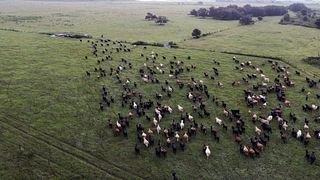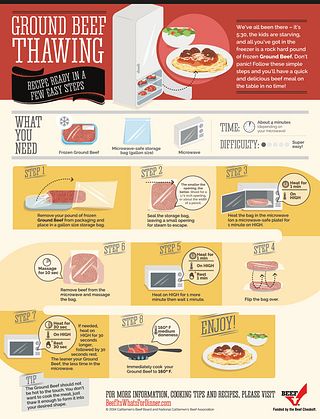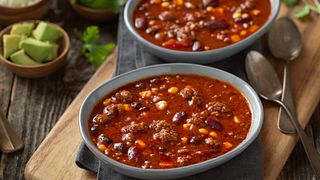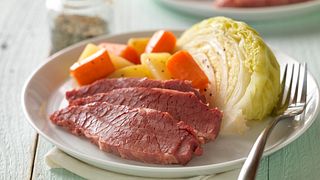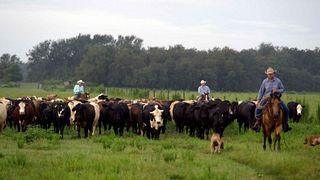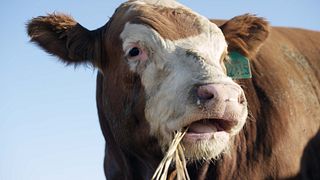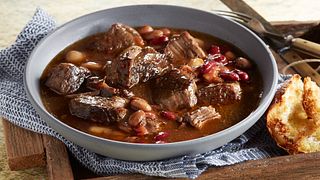Ensuring beef safety, from the farm to your fork
Everyone plays an important role in beef safety – from the cattlemen and women who continually invest in and learn from beef safety research studies to the various government entities that are responsible for enacting and overseeing food safety regulations and inspections. And even you – the folks who select, purchase and prepare beef – play a vital role in maintaining beef safety standards when it comes to proper food handling and cooking practices.
Let’s explore the essential function that safety plays across the beef lifecycle journey – from the cattle ranches across the U.S., to the meat processing plants, to your kitchen table:
Safety in the Beef Lifecycle
"At the end of the day I know that a family is going to be enjoying the beef that originated from my ranch, and I want to do everything I can to be sure it’s safe and delicious.". – Troy Hadrick, Rancher, Faulkton, South Dakota
How Beef Quality Assurance Guidelines and the Latest Beef Safety Research Work to Ensure Safe Cattle Raising Practices
The beef community has a long-standing commitment to providing the public with the safest beef possible – a pledge that is backed by research, best practices and public education. The Beef Quality Assurance (BQA) program, an industry-developed program that provides ranchers with the latest proper cattle management techniques, aims to ensure the consumer, the animal, the environment, and the beef community are cared for within guidelines and regulations. BQA was designed for farmers and ranchers by cattlemen, veterinarians, and animal scientists by creating educational resources which promote good management practices based in science and aligning with government guidelines.
The program couples common sense cattle handling techniques with accepted scientific research to help farmers and ranchers raise cattle under optimum conditions.
More than 100,000 farmers and ranchers have voluntarily signed up to be part of BQA, which is a testament to the beef community’s commitment to animal welfare and safety.
For more information about beef safety research, read the 2017 Cattlemen's Stewardship Review.
"We work with our veterinarian and nutritionist to develop animal care programs to keep our cattle healthy and provide a good environment for raising safe beef."– Garrett Foote, Stocker/Backgrounder, Texico, New Mexico
The Role of the U.S. Department of Agriculture (USDA) in Monitoring Safe Beef
The United States has worked hard to generate one of the safest food supplies in the world. The U.S. Department of Agriculture’s Food Safety and Inspection Service (FSIS) is the agency responsible for ensuring that the commercial supply of meat, poultry and egg products in the U.S. is safe, wholesome, and correctly labeled and packaged.
The Federal Meat Inspection Act requires USDA inspectors to provide inspection of live cattle before entering a federally-regulated establishments. Inspectors also oversee where beef is cut and packaged and the finished meat products are prepared for shipment to their final destinations.
FSIS inspectors utilize numerous tools, tests, and levels of federal inspection to assure product safety. These safety procedures involve collecting and analyzing food samples for harmful bacteria, foodborne pathogens and chemical contamination. As soon as FSIS learns of a potentially unsafe or mislabeled meat product, they conduct a preliminary investigation to determine whether there is a need for a recall. In the instance an unsafe product is identified, a recall is issued as an example of the U.S. food safety system working to remove the product from commerce. If a recall is necessary, FSIS notifies the public through a Recall Release distributed to media outlets where the product was distributed and is posted on the USDA-FSIS website.
While the industry works to provide safe, raw products, you can contribute to the safety of your food by following the proper food handling, cooking and storage steps. Proper cooking is a critical step in beef safety. All ground meat products should be cooked to an internal temperature of 160F, using an instant read meat thermometer. Roasts and steaks should be cooked to a minimum internal temperature of 145F and allowed to rest for at least 3 minutes. To avoid potential cross-contamination during preparation, cooking surfaces should be kept clean and separate utensils should be used to handle raw beef. Hands and utensils should be washed with soap and warm water. Following these steps can help prevent foodborne illness.
Ground Beef Safety
Food Safety at Home
You play an important role in the safety of all foods that enter your home. You should keep products properly refrigerated, surface areas clean and use a meat thermometer to ensure safe cooking of the foods that go on your dinner table. Here are some tips to keep in mind when it comes to preparing beef.
- Purchase beef that is cold to the touch, with no holes or tears and choose packages without excessive liquid.
- If it will take more than 30 minutes to get home, keep an insulated cooler in the car to keep beef and other perishables cold.
- Properly store raw beef in the fridge or freezer. Keep raw beef cold until time of preparation. Try to use fresh beef within two days; otherwise freeze until needed. (You can freeze beef in its original packaging up to two weeks. For longer storage, wrap in heavy-duty aluminum foil or in plastic freezer bags, removing as much air as possible.)
- If frozen, defrost beef in refrigerator (allow at least a day by placing frozen package on a plate or tray to catch any juices), microwave oven, as part of cooking, or under cold running water. Never thaw or defrost beef at room temperature.
- Not all frozen foods are fully cooked or ready to eat. Products may be labeled with phrases such as "Cook and Serve," "Ready to Cook" and "Oven Ready" to indicate they must be cooked. Make sure you read the instructions on the packaging for proper cooking instructions.
- Prepare beef on a clean work surface. Use separate knives, cutting boards and cookware for raw and cooked beef to avoid potential cross- contamination.
- Use plastic cutting boards for raw beef products because wood grains can harbor bacteria and are harder to keep clean.
- Wash your hands before and after handling raw beef with soap and warm water (lather for at least 20 seconds or sing the “happy birthday” song).
- To enjoy safe and savory Ground Beef, remember to use a thermometer as color won’t always indicate doneness.
- Cook Ground Beef to a minimum of 160˚F, using an instant read meat thermometer. For Ground Beef patties, insert the thermometer from the side to the center of the patty. Steaks and roasts should be cooked to at least an internal temperature of 145˚F, using an instant read meat thermometer and let rest for three minutes before serving.
- Be sure to wrap or store leftovers in airtight containers promptly after serving (within two hours after cooking). Keep refrigerated and use within three days.
A Note About Thawing and Cooking
When time is tight and you’re in a pinch to get that Ground Beef meal on the table, try this easy microwave thawing process.
While cooking on “high” or over a “searing hot skillet” may be recommended by some professional chefs, for the home cook, the result is often food that is charred on the outside and raw on the inside (or completely overcooked all around). When it comes to evenly cooked steaks and roasts, and your health, the best recommendation is to have your appliances on MEDIUM heat levels, whether you’re oven roasting, grilling or pan roasting.
Rest assured, all the recipes you’ll find on our site have been triple-tested on medium heat and are guaranteed to have delicious results.
